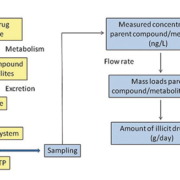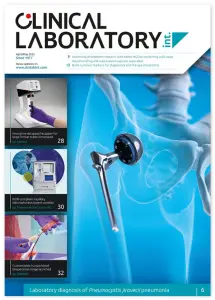Use of LC-MS/MS to measure new psychoactive substances in sewage: an application of sewage-based epidemiology
This contribution describes the possibility of applying liquid chromatography coupled to tandem mass spectrometry for analysing sewage in order to track down the use of new psychoactive substances.
by J. Kinyua, Prof. A. Covaci, Prof. A. L. N. van Nuijs
Introduction
Sewage-based epidemiology (SBE) is an alternative method of monitoring population drug use by the analysis of excretion products of drugs in sewage (Fig. 1). SBE has been applied since 2005 as a complementary approach to classical investigation methods, such as interviews with users, medical records, population surveys, and crime statistics for estimating illicit drug use in communities [1–3]. Data obtained from SBE provide information on drug use in a direct, quick and objective way.
New psychoactive substances (NPS) are substances that are not controlled by the 1961 United Nations Single Convention on Narcotic Drugs or the 1971 Convention on Psychotropic Substances and that may pose a threat to public health [4, 5]. These compounds mimic effects of illicit drugs like cocaine, cannabis and amphetamines and are produced to evade law enforcement by introducing slight modifications to chemical structures of controlled substances [6]. Currently, more than 450 NPS are being monitored by the European Monitoring Centre for Drug and Drug Addiction (EMCDDA) with 101 new substances reported for the first time in 2014 to EU Early Warning System (EWS). Synthetic cannabinoids and synthetic cathinones are the largest groups in the NPS scene [7]. NPS are easily acquired through online vendors and in smart shops where they are sold with misleading information about their effects and safety [8]. They are considered a growing problem in many communities and are responsible for numerous fatal intoxications [9]. SBE has the potential to be usefully applied for the detection and quantification of NPS to document their occurrence to appropriate authorities. Being an emerging issue, only a few studies have applied SBE for the analysis of NPS [10–13]. In this contribution, the optimization, validation and application of an analytical method using liquid chromatography coupled to positive electrospray tandem mass spectrometry (LC–ESI-MS/MS) for the determination of seven NPS in sewage: methoxetamine (MXE), butylone, ethylone, methylone, methiopropamine, 4-methoxymethamphetamine (PMMA), and 4-methoxyamphetamine (PMA) is described together with a critical evaluation of the methodology.
LC-MS/MS methodology
An LC-MS/MS method was developed and validated using a Phenomenex Luna HILIC (hydrophilic interaction liquid chromatography) 200A (150 x 3 mm, 5 µm) column, with a mobile phase composed of A) 5 mM ammonium acetate in ultrapure water and B) acetonitrile. The mass spectrometer compound dependent parameters, fragmentor voltage and collision energy, were optimized to acquire two multiple reaction monitoring (MRM) transitions (qualifier and quantifier) for each compound, and one MRM for the internal standards (IS). The method was validated, assessing accuracy and precision, using blank sewage (samples collected prior to 2009 in which NPS have not been detected). A linear range with lower limits of quantification (LLOQ) of 0.5 ng/L (MXE and methylone) and 2 ng/L (all other compounds) and upper limits of quantification (ULOQ) of 200 ng/L was achieved for investigated compounds. The limit of detection (LOD) was between 0.02 and 0.2 ng/L for all compounds.
Sample collection and preparation
24-h composite influent sewage samples were collected from different wastewater treatment plants (WWTPs) in Belgium and one WWTP in Zurich. Before sample extraction, 50 mL sewage was filtered through a 0.7 µm glass filter to remove solid particles. After filtration, the samples were brought to pH 2 using a 6 M HCl solution and spiked with deuterated IS at a concentration of 100 ng/L. Thereafter the solid-phase extraction (SPE) procedure was performed using a mixed-mode strong cation exchange sorbent-Oasis MCX (Fig. 2).
Application of the procedure
The method could reliably differentiate the analytes and IS from endogenous components. MXE, methylone and ethylone could be detected. The method revealed the presence of MXE in sewage from five urban centres within two counties in Belgium. Methylone was detected and quantified in only two samples from Switzerland at levels slightly higher than LLOQ (Fig. 3). The compounds that were not detected could be absent in the sewage or present in the form of metabolites which were not targeted in the present study.
Advantages/limitations of the SBE methodology
Phenylethylamine-based compounds (synthetic cathinones and amphetamine-like substances) form a large group of NPS and they are very polar. Hydrophilic interaction was found to be a good and robust LC stationary phase to obtain retention for these high-polarity compounds. Furthermore, we showed for the first time in SBE that the use of a more realistic matrix for method development, such as real sewage, can help in overcoming challenges associated with matrix effects in MS detection. The results from these samples demonstrate the importance of developing highly sensitive analytical methods that can detect and quantify NPS at very low concentrations (<10 ng/L).
Limitations of the present methods
It is difficult to determine if the low drug concentrations in sewage are related to low popularity of the NPS or due to the presence of an unknown form of the parent drug in sewage, urinary metabolites or transformation product from other in-sewer processes. SBE requires a specific, reliable and stable biomarker for the NPS of interest. Further studies on the metabolism and in-sewer transformation processes (which may affect stability of drug residues) of NPS needs thus to be carried out to provide SBE with information regarding additional biomarkers of NPS parent drugs.
Future of SBE in NPS analysis
Concentrations of NPS in sewage may be low depending on the area served by the WWTP and on the prevalence of its use [14]. Therefore, pooled urine analysis would be useful in detecting the occurrence of NPS before dilution into sewage [15]. It would be a valuable approach to combine pooled urine analysis and SBE to track down the actual use of NPS in communities.
Conclusion
In conclusion, SBE can help in revealing the occurrence of NPS within catchment areas of urban centres and showed the need to develop very sensitive analytical methods to detect NPS in sewage.
References
1. Bijlsma L, Sancho JV, Pitarch E, et al. Simultaneous ultra-high-pressure liquid chromatography-tandem mass spectrometry determination of amphetamine and amphetamine-like stimulants, cocaine and its metabolites, and a cannabis metabolite in surface water and urban wastewater. J Chromatogr A 2009; 1216: 3078–3089.
2. Boleda MR, Galceran MT, Ventura F. Trace determination of cannabinoids and opiates in wastewater and surface waters by ultra-performance liquid chromatography-tandem mass spectrometry. J Chromatogr A 2007; 1175: 38–48.
3. Huerta-Fontela M, Galceran MT, Ventura F. Ultraperformance liquid chromatography-tandem mass spectrometry analysis of stimulatory drugs of abuse in wastewater and surface waters. Anal Chem 2007; 79: 3821–3829.
4. United Nations Office on Drugs and Crime (UNODC). Global synthetic drugs assessment. (United Nations publication, Sales No. E.14.XI.6), 2014. http://www.unodc.org/documents/scientific/2014_Global_Synthetic_Drugs_Assessment_web.pdf
5. King LA, Kicman AT. A brief history of ‘new psychoactive substances’. Drug Test Anal. 2011; 3: 401–403.
6. Dargan PI, Wood DM. Novel psychoactive substances classification, pharmacology and toxicology. Elsevier/Academic Press, 2013. ASIN: B00FK8HYY2.
7. European Monitoring Centre for Drugs and Drug Addiction (EMCDDA). New psychoactive substances in Europe. An update from the EU Early Warning System, 2015. http://www.emcdda.europa.eu/publications/2015/new-psychoactive-substances
8. EMCDDA. EMCDDA–Europol 2013 Annual Report on the implementation of Council Decision 2005/387/JHA, 2014. http://www.emcdda.europa.eu/publications/implementation-reports/2013
9. Vevelstad M, Øiestad E.L, Middelkoop G, et al. The PMMA epidemic in Norway: Comparison of fatal and non-fatal intoxications. Forensic Science International 2012; 219: 151–157.
10. Kinyua J, Covaci A, Maho W, et al. Sewage-based epidemiology in monitoring the use of new psychoactive substances: validation and application of an analytical method using LC-MS/MS. Drug testing and analysis 2015 ( In press).
11. Reid M.J, Derry L, Thomas K.V. Analysis of new classes of recreational drugs in sewage: Synthetic cannabinoids and amphetamine-like substances. Drug Test Anal. 2014; 6: 72–79.
12. Van Nuijs ALN, Gheorghe A, Jorens PG, et al. Optimization, validation, and the application of liquid chromatography-tandem mass spectrometry for the analysis of new drugs of abuse in wastewater. Drug Test Anal. 2014; 6: 861–867.
13. Kankaanpää A, Ariniemi K, Heinonen M, et al. Use of illicit stimulant drugs in Finland: a wastewater study in ten major cities. Sci Total Environ. 2014; 487: 696–702.
14. Archer JRH, Dargan PI, Lee HMD, et al. Trend analysis of anonymised pooled urine from portable street urinals in central London identifies variation in the use of novel psychoactive substances. Clinical Toxicol (Phila). 2014; 52: 160–165.
15. Archer JRH, Dargan PI, Hudson S, et al. Analysis of anonymous pooled urine from portable urinals in central London confirms the significant use of novel psychoactive substances. QJM 2013; 106: 147–152.
The authors
Juliet Kinyua MSc, Adrian Covaci PhD, Alexander L.N. van Nuijs* PhD
Toxicological Center, University of Antwerp, Belgium
*Corresponding author
E-mail: alexander.vannuijs@uantwerpen.be



